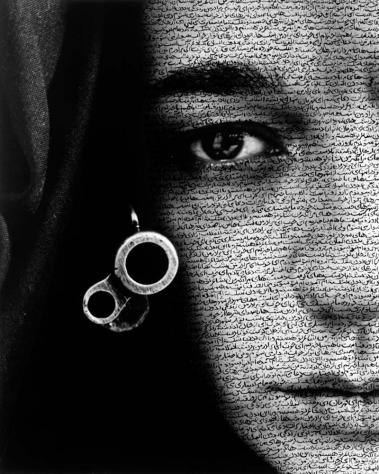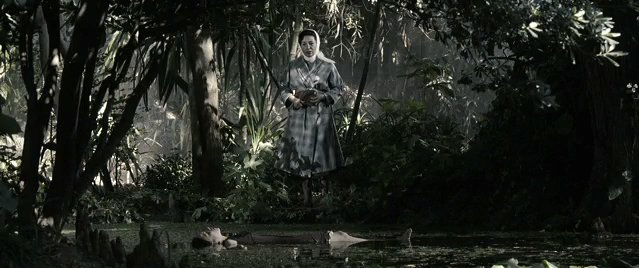|
In an era marked by global political tensions between East and West, Shirin Neshat is one of the most poignantly relevant artists today. However, given the current political climate, it is easy to misread the “Women of Allah” series, which first brought her notoriety as an artist. A series of black and white images, containing four unifying visual elements: a woman donned in the traditional Islamic veil or chador, a rifle or Kalashnikov, poetry written in Farsi, and a gaze that confronts the viewer. One would be mistaken to assume that these are portraits of female Islamic radicals or jihadists. The complexity of the works requires some knowledge of the context in which they were created. Firstly, “Women of Allah” was created between 1994- 97, several years before the pivotal turning point of 9/11 and the ensuing onslaught of Islamaphobia. Born in Iran in 1957, Neshat grew up under the rule of Mohammad Reza Shah Pahlavi who embraced Western ideologies and supported reforms that encouraged the education of women and instituted family laws to be more favourable towards women. In Neshat’s late teens, during the mid 1970’s, her father sent her to the U.S. to pursue higher education in Los Angeles, California. A few years later, the Islamic Revolution of 1979 broke out. Citizens had grown weary of the Shah’s autocratic methods of governance and his lack of regard for the Islamic religion. Unfortunately, his embrace of modernity and Westernism was tainted by this autocractic disregard for democratic methods. Initially, many Iranian women began wearing the veil in the 70's as a form of protest against the Shah, both exhibiting the love of their religion and their rejection of the Shah's Western ideologies. However, after the Islamic Revolution, suddenly women no longer had a choice. The man that they had democratically placed in power, whom they put their trust in to uphold their values, turned on them, took away many of the rights and privileges that these women had grown up with, and, almost symbolically so, it became mandatory that women wear the veil in public at all times. “In a way, by studying a woman, you can read the structure and the ideology of the country.” Shirin Neshat; Ted Talks In 1991 Shirin Neshat was finally able to return to Iran and to be with her family. But, Neshat has repeatedly said in public presentations, she no longer recognized her homeland, which had transformed into a state of Islamic fundamentalism. Perhaps one of the most glaringly obvious visual signifiers of this theocratic transformation may have been that the face of women were literally, no longer visible. In her talk at Princeton University Neshat stated “The women of Iran, historically, seem to embody the political transformations”. She returned to the U.S. not so much inspired as compelled by the transformation that she had witnessed. And so, in 1993, she began working on her “Women of Allah” series. Upon examining each of the four elements that appear in the works it seems that In their entirety the work is loaded with symbolism and fraught with contradictions. The veil is simultaneously a symbol of repression and a rejection of Western ideology. While many Westerners believe that the veil it is simply a repressive garment, the contradictory notion is that when covered, women are free from the repression of being an object of sexual desire through the male gaze. Feminist Iranian poetry is written on the women’s faces, feet and hands, in essence “covering” those parts of a woman’s body, which are required to be covered. But the covering by text in these works allows the women a voice where they are otherwise silenced. The texts themselves are poems of female martyrdom by an Iranian woman, Tahereh Saffarzadeh. Interestingly Neshat creates a contradiction because in Islamic Fundamentalist countries, “martyr” is a term most commonly reserved for men, whereas women are more likely to be ascribed the term “victim”. Shirin Neshat states that she feels ambivalent about martyrdom. While she is proud of the women of her homeland for challenging authority, there is a contradiction that she has captured in her portraits – the softness and beauty of their young skin with the coldness of the rifles, symbol of cruelty, violence and death. She has found inspiration in the resilience of Iranian women who fought to defend their borders when Iraq attacked Iran in 1980, hoping to take advantage at the point of political instability, in what is now known as the Persian Gulf War. Women have also been at the forefront of peaceful demonstrations, banding together in several protests including the Green Movement and the Arab Spring. It is these women that Neshat admires for their courage. Without forgetting her own Western education and influence, and having gone to university in the U.S. at the crux of second-wave feminism in the 1970’s, Shirin Neshat has imbued her subjects with a gaze that simultaneously confronts and defies the male gaze. Perhaps the most poignant image in the series is this one pictured below, in which the face of the women is bisected by the barrel of the rifle, just as Shirin Neshat’s own life and has been bisected by Islamic and Western influences. Exiled from her homeland of Iran since 1996, Shirin Neshat has been living a nomadic lifestyle as an artist. Her oeuvre has extended beyond the still photograph into film and video. Her 2009 film “Women Without Men” won the Silver Lion Prize for Best Directing at the Venice Film Festival. Although shot in Morocco due to Shirin’s ban from Iran, the film takes us back to the Iranian capital of Tehran to a pivotal time in Iranian history, which informs much of Neshat’s earlier work. It is set in 1953, the year when a coup d’etat encouraged and backed by British and American armed forces overthrew Iran’s then democratically elected president and instated the Shah as ruler of Iran. Continuing to explore gender roles of Iranian women, “Women Without Men” follows the tale of four women of varying age and class, brought together by a rejection of male oppression. Munis, who is interested in political activism, lives under the tyranny of her brother who tells her that he will break her legs if she leaves the house, eventually driving her to dive off the roof of their home, or at least imagines she does. The novel the filmis based upon draws upon "creative realism" allowing Munis to come back from her suicide in a second life where she comes as goes wherever she desires, at free will. Munis's best friend, Faezeh, is raped by two men one afternoon after gazing into a cafe where women are not allowed; she is understandably traumatized after the event. The young Zarin is confined to a life of enslavement as a prostitute, ravaging both her physical and mental health. Fakhri an older, upper-class housewife of a military general, is told by her husband that if she can no longer satisfy him sexually, he will take a younger wife. Having the most liberty of all the women featured, she leaves him, purchasing a villa in the countryside as a place for escape to begin a new life free from his presence and repression. Seeking refuge 3 of the women eventually find each other in the orchard and recover together in the villa where they can exist in freedom, without their veils of oppression. However, when men arrive at the orchard one night for a party, their secure haven is “raped” by their presence. The most fragile of them, Zarin, loses her life, perhaps in fear that she will never be safe. The film was adapted from the novel by Iranian author Shahrnush Parsipur, which is banned in Iran. The film "Women Without Men" exemplifies the strong, beautiful, and poignant style that has marked the still photographic works of Shirin Neshat. With its myriad of layers, the film is infinitely complex - weaving together both national and gender politics. No two characters are alike - ranging from the most traditional Islamic young women who are still virgins as they near the age of 30 and won't (or can't leave) their homes without a suitable escort or donning a chandor, to the very Westernized, culturally elite older woman who enters public places like restaurants without a veil, smokes cigarettes, listens to music and sings, purchases property without her husbands presence, drives about in an American automobile, and throws parties for the like of artists, actors, and other well-to do socialites. The film beautifully captures the depth of each character and their internal states through a physical terrain. Drawing from Shirin Neshat's earlier use of poetic symbolism, this physical terrain is poetically depicted in the forms of the hard concrete streets and buildings of Tehran; a long, lonely road leading to the possibility of change; a wall that separates the orchard from the outside world (as seen above) with an opening small enough to enter as water flows freely through it; the dark, barren forest; the dense foggy marsh that Zarin is found floating nearly dead in (seen below); and the lush jungle-like garden which rays of sunshine pierce through in a stroke of optimisim. The orchard becomes a place where these women can escape their veils of oppression, as so poignantly conveyed by the veil dropped outside the wall. Outside the garden walls, back in the city, all is not well as the political climate comes to a boil. Like a barometer throughout the film, Zarin's health, which had been improving in her new surroundings of hope, finally takes a turn for the worst as the military clashes with the Iranian citizens, overthrowing the democratic government and instating the Shah to power. "This film is dedicated to the memory of those who lost their lives in the struggle for freedom and democracy in Iran from the Constitutional Revolution of 1906 to the Green Movement of 2009." (Women Without Men) Bibliography:
Humanitas: Shirin Neshat at the University of Oxford, Lecture – YouTube https://www.youtube.com/watch?v=pySIgzyDvKk&ebc=ANyPxKqxD84_4HLSkW-CRBpZ0Zquxn01rKDkoF8oTad2Y4kGQ7Yosp9emoOAYwM94h3bkowldKKLDhNqosW66U4FAhZZJTU7Aw Shirin Neshat: Art in exile – YouTube https://www.youtube.com/watch?v=4YS3gGpnPe8 http://womenwithoutmen.blog.indiepixfilms.com/ https://en.wikipedia.org/wiki/Iranian_Revolution http://blog.movements.org/how-iranian-women-are-dealing-with-their-oppression/ Shirin Neshat, Women of Allah Series https://teachartwiki.wikispaces.com/Shirin+Neshat,+Women+of+Allah+Series Green Women of Iran: The Role of the Women’s Movement During and After Iran’s Presidential Election of 2009 https://www.sssup.it/UploadDocs/18086_7_S_Green_Women_of_Iran_The_Role_of_the_Women_s_Movement_During_and_After_Iran_s_Presidential_Election_of_2009_Victoria_Tahmasebi_Birgani_13.pdf https://en.wikipedia.org/wiki/Women's_rights_in_Iran#Women_and_the_Iranian_Revolution https://www.lib.uchicago.edu/e/webexhibits/iranianposters/womenandchildren.html http://isismagazine.org.uk/2014/07/women-of-allah-an-interview-with-exiled-artist-shirin-neshat/ http://www.washingtoncitypaper.com/articles/47170/shirin-neshat-facing-history-at-the-hirshhorn-reviewed-in-her/ http://www.gladstonegallery.com/artist/shirin-neshat/work http://www.gladstonegallery.com/artist/shirin-neshat/biography https://en.wikipedia.org/wiki/Women_Without_Men_(2009_film) http://womenwithoutmen.blog.indiepixfilms.com/about/ The 'beauty' and the horror of the Iran-Iraq war - BBC News http://www.bbc.com/news/magazine-34353349 Iran's Basij Sisters suppressed election protests https://www.alarabiya.net/articles/2009/08/05/80895.html Iran–Iraq War - Wikipedia, the free encyclopedia https://en.wikipedia.org/wiki/Iran%E2%80%93Iraq_War Iran Chamber Society: Iranian Society: Women in Iran Since 1979 http://www.iranchamber.com/society/articles/women_iran_since_1979.php When Walls Come Falling Down: Left Political Art Timeline, 1989-2000 http://www.huffingtonpost.com/g-roger-denson/9892000_b_1422848.html Iran: Women protest against forced wearing of hijab, 1979 http://www.jihadwatch.org/2014/04/iran-women-protest-against-forced-wearing-of-hijab-1979 Iran's Women A Driving Force Behind Green Movement http://www.huffingtonpost.com/2009/07/24/irans-women-a-driving-for_n_244218.html In Iran, One Woman's Death May Have Many Consequences – TIME http://content.time.com/time/world/article/0,8599,1906049,00.html Accidental Martyrdom and the Ambiguous Death Image of the Role of Iranian Women | iranianstudies.com http://iranianstudies.com/content/accidental-martyrdom-and-ambiguous-death-image-role-iranian-women Iraq's war on women | openDemocracy https://www.opendemocracy.net/conflict-iraqconflict/women_2681.jsp BBC NEWS | Middle East | Iran-Iraq war: Iraqi women's stories http://news.bbc.co.uk/2/hi/middle_east/4268530.stm Women's rights in Iran - Wikipedia, the free encyclopedia https://en.wikipedia.org/wiki/Women%27s_rights_in_Iran#Women_and_the_Iranian_Revolution Shirin Neshat | Signs: Journal of Women in Culture and Society http://signsjournal.org/shirin-neshat/ Shirin Neshat, Rebellious Silence, Women of Allah series | Asia, Africa, Europe, Latin America and the Middle East | Khan Academy https://www.khanacademy.org/humanities/global-culture/identity-body/identity-body-europe/a/neshat-rebellious
0 Comments
|
Holly Marie Armishaw
Based in Vancouver, Canada, Holly Marie Armishaw is a contemporary artist, art writer, francophile, and world traveler. Through rigorous exploration of inspiration from international sources of art and culture, she infuses her insights with a critical eye as she discusses global trends. Both her art and writing are informed by attending a continuous array of art exhibitions, lectures, fairs and biennales, both at home and abroad. Articles
All
|





 RSS Feed
RSS Feed
